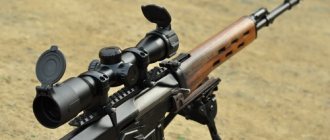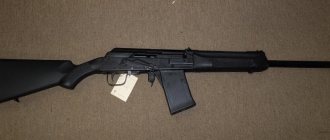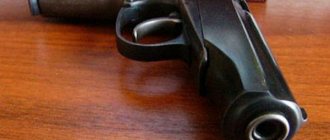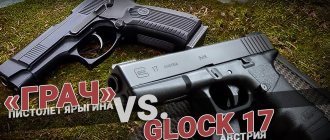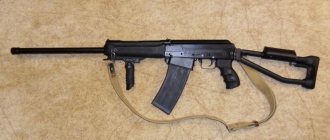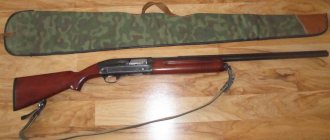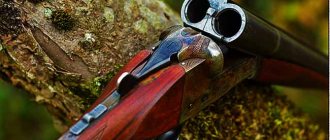410 caliber cartridges with weapons for it appeared in our country in the 90s of the last century . The caliber has been popular in England and the USA for a long time. The weapon was actively used by farmers already at the end of the 18th century to shoot harmful birds, snakes, rodents, and for recreational shooting.
The founder of the serial mass production of cartridges was. The cartridge was eventually adopted by hunters. In our country, some hunters are skeptical about the 410 caliber, but this is not an obstacle to the constant growth of its popularity.
General information about the caliber
The diameter of a 410 caliber bullet is 10.2-10.4 mm . This is the lowest-power cartridge in the line of rifle ammunition. Used for hunting small game and as a sporting or recreational load. It is produced both in our country and abroad. The quality and ballistic characteristics of the products differ significantly from each other . The spread of parameters is large, a unified approach to the procedure for loading a cartridge has not been worked out, competition between manufacturers contributes to the search for more advanced samples.
The cartridge can be loaded with shot, buckshot, or bullet. Buckshot is practically not used for shooting with this caliber. The shot used is the same as for large caliber shotguns.
Experiments on the bullet have not stopped since the creation of the cartridge to the present day. Many bullets have been created, varying in their ballistic parameters and damaging properties. Factory and home-made bullets, often cast at home, are used as a charge.
Depending on the type of choke tubes and the mode of passage of the projectile through the barrel, the following types of bullets are used:
- Sub-caliber.
- Caliber.
- Over-caliber.
The most popular bullets currently are Foster or Brenneke bullets. The cost of a factory cartridge of 410 caliber is 1.5-2 times higher than a similar product of 12, 16 caliber. For this reason, many gun owners load their own ammunition. The process is completely identical to the technology for loading rifle cartridges of traditional calibers. If you have the appropriate equipment, the work is not difficult or time-consuming. The cost of a cartridge, when reloading spent cartridges, is reduced by 2-2.5 times . The quality of homemade products is not inferior to the properties of factory products. Depending on the length of the chamber, 70 mm or 76 mm sleeves are used. Longer 76 mm sleeves are used to equip the reinforced magnum .
The most common 410 caliber weapon in our country is the Saiga-410 . The weapon has been produced since the cartridge was certified in 1996. Izhevsk designers developed the MP-27EM 1C 410 76 . This is a lightweight 410 caliber double-barreled shotgun with a vertical barrel arrangement. Single-barreled weapons are represented by the IZH-18M-M .
Ball bullets are the most common load among our hunters. The projectile is far from perfect, but it is easy to manufacture, has good ballistics and is low cost. Shooting a bullet is effective at a distance of up to 50 meters . According to this indicator, 410 caliber weapons are not inferior to 16 and 12 caliber guns, but at the same time demonstrate a much lower stopping effect, since the bullet mass is only 6-10 g . A 12 gauge bullet weighs 27-35 g .
The shot load of the cartridge is small; the number of pellets is not capable of providing a dense scattering of the target. Shooting with large shot at targets located further than 25 m from the hunter is not effective. With small shot No. 7 and smaller, the probability of a successful hunt tends to zero. A small spread of shot, even at a lethal distance, is not capable of confidently hitting a fast-moving target.
caliber cartridge does not exceed 800-900 J. This is clearly not enough for hunting big game.
My 410th paradox
The Saiga-410 hunting carbine is still very popular among a large army of shooters and lovers of the “militaristic” style of weapons. How to achieve super-powerful and super-precise combat from this, at first glance, ineffective, but so dear to the heart weapon? Answered by a regular author of our magazine, a keen expert in his field, Mikhail Trushechkin.
Photo 1
I have addressed the problem of .410-caliber ammunition several times in my articles. This can be explained quite simply: being the owner of the Saiga-410 myself, I wanted to fully realize the capabilities of my weapon, as well as the capabilities of the .410 caliber as such. Unfortunately, factory-made ammunition entering our arms market is more likely to upset or even disappoint the discerning shooter.
At the same time, the results of a survey I conducted in a number of metropolitan gun stores indicate that the demand for Saiga-410 is still stable. Therefore, I hope that the content of this article will be interesting to readers. This time we will talk about “paradoxes” and ammunition for them. Drilling "paradox" does not apply to new weapons. The patent for this invention was received by the English Colonel Fosbury back in 1884. The essence of the invention was that the choke constriction of an ordinary smooth shot barrel was supplied with rifling. The idea was based on the desire, while maintaining the main function of a shotgun (that is, shooting with shot), to bring the combat of a bullet from it as close as possible to the combat of a rifle. Until 1910, the patent for Fosbury's invention belonged to Holland & Holland. After the patent expired, many companies began to produce weapons with barrels of similar drilling. The combat with a bullet from the “paradox”, of course, was superior in accuracy to the combat of a regular “cylinder”, however... you have to pay for everything, and very soon several very unpleasant “sins” were noticed behind the “paradoxes”. Firstly, lead rifling occurred in them an order of magnitude faster than in fittings and became noticeable after 3-5 shots! As a result, all the advantages of drilling came to naught, and cleaning heavily leaded rifling was a very labor-intensive task. Secondly, the quality of shot powder still decreased compared to conventional “chokes”, especially when containers were used. And finally, the cost of producing “paradoxes” was noticeably higher than conventional types of drilling. As a result, the “paradoxical” boom of the beginning of the century gradually began to wane. In our country, until very recently, drilling “paradox” was not widespread. Rarely have any hunters encountered it in their lives. I said until recently, because recently the use of choke tubes of various configurations has become increasingly common practice. With their help, the shooter can quickly vary the capabilities of his weapon according to the hunting profile. The appearance of “paradox” type attachments was not long in coming. About a year and a half ago, in one of the Moscow arms stores, I first saw a “paradox” for Saiga-410. I’ll say right away that this device did not arouse much enthusiasm in me. It had four very small, almost symbolic, and very steep (with a pitch of about 150-200 mm) grooves, which fundamentally contradicted my ideas about what a “paradox” should be.
And finally, six months ago, in the “Gunsmith” store on Malaya Molchanovka, I came across another version of this type of choke tube. The rifled part of the “paradox” had eight rifling with a pitch of about 450 mm. The rifling caliber was 10.25 mm, the margin was 9.95 at the beginning and 9.85 at the muzzle. Tests were carried out with this muzzle attachment, the results of which I would like to introduce to the reader.
Photo 2
The picture clearly shows that already at the entrance the rifling has a sufficient depth, increasing towards the muzzle. It must be borne in mind that a simple measurement of the accuracy of hits essentially says nothing about how the “paradox” works. It is widely known that the use of lead bullets with easily crushable longitudinal ribs or transverse bands in barrels with light choke constrictions in itself provides some improvement in combat. And any decent “paradox”, by definition, has a choke constriction, and therefore the improvement in accuracy may not be due to rifling at all.
At the time when Fosbury took out his patent, the speed of bullets from smoothbore hunting weapons rarely exceeded 330-350 m/s. The deep (up to 0.25 mm!) and very gentle (up to 1000 mm) rifling of the “paradoxes” of the late 19th century could well “hook” a lead bullet and give it a rotational movement. And what will happen in the “paradox” of the Saiga-410, the barrel of which the bullet leaves at speeds sometimes exceeding 500 m/s?
The answer to the question whether the “paradox” works, that is, whether it imparts real axial rotation to the bullet on the order of several hundred revolutions per second, can only be given... by the bullet itself! Of course, in order to make it possible to study the spent bullet, and not what is left of it, it is necessary to create braking conditions that exclude its deformation. In my experiments I used rag bags and gelatin blocks.
The shooting was carried out using a chronograph (a device that determines the speed of a bullet).
Photo 3
As far as I know, .410-caliber cartridges designed for use with the paradox drill are not produced either in our country or abroad. Therefore, I used all-lead caliber cylindrical bullets with a diameter of 10.25-10.28 mm of various weights. The first results appeared quite quickly.
Table 1
| Bullet weight, g | Powder mass, g (Falcon) | E0,J | Speed V0, m/s | Rotation speed, r/sec |
| 15 | 0,3 | 306 | 202 | 450 |
| 15 | 0,6 | 836 | 334 | 350 |
| 15 | 1,0 | 1399 | 432 | <200 |
Photo 4
Image of all three bullets. It is clearly visible that the left bullet Vo = 202 m/s bears clear traces of the passage of rifling while maintaining the pitch length of the rifling of the nozzle, that is, 450 mm. At a speed of 334 m/s, there is a noticeable flattening of the steepness of the rifling. At a speed of 432 m/s (right-handed bullet), the rifling marks are almost straight. At speeds of the order of 500 m/s in experiments with lighter bullets, the steepness of the rifling tends to zero. By dividing the initial velocity of the bullet by the pitch length of the rifling marks obtained by measuring the fired bullets, we determine the approximate rotation speeds (see Table 1). So, experiments show that the axial rotation caused by the passage of the rifled nozzle and providing the bullet with flight stability at initial speeds above 460-480 m/s is almost completely lost. Inspection of the target gives a complete correlation with the measurement results: with increasing speed, the accuracy decreases. At speeds above 480 m/s, bullets begin to tumble, leaving specific marks on targets and causing increased chaotic spread.
table 2
| Bullet weight, g | V0 | Accuracy at 25m, cm |
| 15 | 200-250 | 6-9 |
| 15 | 300-350 | 12-15 |
| 15 | 400-450 | about 20 |
| 10 | > 500 | over 20 |
Thus, the accuracy of the “paradox” combat at bullet speeds over 400 m/s approaches the combat of a cylinder with the worst cartridges produced by the Krasnozavodsk Chemical Plant. However, negative experience is also experience. The positive aspect of the first series of experiments was that the “paradox” still provided the bullet with stability, that is, forward movement of the nose at speeds of up to 450 m/s. This opened up the possibility of widespread use of hollow-point bullets in .410-caliber cartridges.
Photo 5
The simplest in design and production technology, they demonstrated high efficiency in experiments with gelatin blocks.
The density of 10% gelatin is known to be close to the density of human body tissue, which makes it possible to use it as a simulator in experiments. The passage of a bullet through the block leaves a clearly visible trace of destruction of the internal structure of gelatin.
Photo 6
A gelatin block is depicted with a shot from a Makarov pistol. Shooting a similar block with an expansive bullet weighing 9 g (Vo=460 m/s) gave an explosive effect with complete destruction of the block.
Photo 7
Shown (inside view) is one of these blocks with a clearly visible entrance hole and the explosive nature of the destruction of the internal structure of the material. Experiments have shown that notches on the edges of the expansive cavity are completely unnecessary.
Photo 8
The bullet in its simplest form, which is a cap bullet turned backwards, works excellently in “paradoxes”.
Photo 9
Shown are bullets extracted from gelatin. It is safe to say that in defensive scenarios, none of the bullets produced by our industry have such stopping power. Another valuable conclusion made in the first part of the experiment was the complete debunking of the myth of the “two leading belts.” In my shooting, I used hard lead alloys with a 5% antimony content. The width of the leading belt coincided with the length of the bullet, that is, it was equal to 12-15 mm, and, despite this, the strength of the lead was not enough to reliably cut into the rifling at high initial velocities of a given caliber.
It is quite obvious that when the width of the leading part of the bullet is reduced, failure from the rifling will occur at significantly lower speeds. But still, the main goal of using the “paradox” - increasing the accuracy of the battle - has not yet been achieved. The reason for this is the material of the bullet. More than a hundred years ago, this problem already faced weapons designers. Its solution was found with the advent of shell bullets. Not knowing how aluminum, which is much harder than lead, will behave when faced with a “paradox,” I slightly reduced the caliber (to 10.05 mm). In addition, the leading part of the bullet was divided into three belts. The examination of the spent bullets was extremely instructive.
Photo 10
Image of one of these bullets (Vo=705 m/s). Let's take a closer look at it. You need to have enough imagination to notice at least some inclination in the rifling of the first belt. The second is the beginning of the “twist”. And only on the third belt the steepness of the rifling marks corresponds to the steepness of the “paradox” rifling!
If there were not three belts, but two, or if the belts were narrower, then failure from the rifling would be inevitable. And it's aluminum! What can we say about lead?!
We will not bore you with a description of numerous intermediate experiments. In the final version, the bullet I propose is a turned aluminum cylinder with an internal cavity filled with lead. The mass of the bullet is 7.5 g, the Sokol powder charge weighing 1.25 g provides it with an initial speed of 650 m/s, which corresponds to 1580 J of muzzle energy (which is almost 200 J more than the Eo of the AK-47).
One hunter, turning this bullet in his hands, said contemptuously: “Is this really a bullet?!” Some kind of figurine.” I didn’t argue, although the 7.62 caliber Kalashnikov assault rifle bullet is only 0.4 g heavier.
Photo 11
Image of the fired bullet of the above data. This same bullet pierced 25 cm of pine boards without the slightest harm to itself. Its rotation frequency after passing the “paradox” choke nozzle exceeds 1400 rps, which is more than enough to stabilize the bullet in flight (compare with the data for lead bullets. Table 1). Traces of rifling without the slightest signs of failure. The results are obvious. At a distance of 35 m, bullets of this type gave a group of 3.5-5 cm, which is already quite serious for a smooth-bore weapon! In appearance, the bullet resembles a rifle bullet rather than a shotgun bullet. However, there is nothing strange about this. Rifle ballistics dictate the appropriate shape and design. Of course, one cannot expect any outstanding stopping power from bullets of this type. However, the experiment is encouraging. After several hundred shots of bullets of various shapes and weights, the barrel attachment shows no noticeable signs of wear.
Note.
Bullet shooting using choke tubes in general, and “paradoxes” in particular, requires mandatory zeroing of the weapon for a specific choke tube.
So, it remains to draw the line
- "Paradox" works and works well, but only with ammunition specially manufactured for this purpose.
- “Paradox” opens up the possibility of using cheap and very effective bullets with expansive void for self-defense.
- The use of bullets of traditional designs in “paradoxes” is ineffective.
At the International Arms Exhibition held in early June 1998 in the Moscow Manege, I offered bullets of my design to representatives of the Krasnozavodsk Chemical Plant. The future will tell whether we will see them on store shelves.
Mikhail Trushechkin Master Gun 50-2001
Main factors of popularity
410-caliber shotguns appeared here relatively recently, the peak of their popularity has not yet arrived, but the weapon is already in strong demand in the hunting equipment market. Today we can name 7 reasons for the growing popularity of the caliber:
- Light weight of weapons and ammunition.
- Excellent stability and accuracy of bullet shooting.
- Insignificant recoil force when fired.
- High initial projectile speed.
- Low shot volume.
- Possibility of self-loading cartridges.
- Stability of sight optics settings.
The weight of a cartridge loaded with shot No. 3 with a 76 mm sleeve is 23-25 g , the weight of the shot is 18 g . at 78 pellets, gunpowder weight - 0.9 g . The bullet cartridge is much lighter. With a Foster bullet, the ammunition weighs 20 g . , bullet - 6.4 g , powder weight - 1.19 g .
The Saiga-410 smoothbore carbine weighs 3.3 kg , the IZH-18M-M single-barrel carbine weighs only 2.9 kg . , double-barreled shotgun "MR-27EM 1C 410 76" - 3.2 kg . Thanks to these parameters, you can take a varied arsenal of ammunition with you when hunting.
When shooting bullets at 25 meters, they confidently fit into a round target with a diameter of 50 cm . This is a normal indicator for smooth-bore hunting weapons.
The caliber has the lowest recoil when fired. Weapons are successfully used by people with disabilities.
The muzzle velocity of a 410 caliber bullet is higher than that of similar 12.16 caliber ammunition. The bullet leaves the barrel at a speed of 460-550 m/sec. , this is on average 15-20 percent faster than 12 gauge weapons.
The shot is accompanied by a quiet sound; the sound pressure does not cause discomfort to the shooter. The sound does not travel far without creating an excessive scaring effect.
The high cost of factory-made cartridges forces shooters to equip them independently . Such activity is legal and partially eliminates the above disadvantage. As a rule, for self-equipment, reusable metal cartridges are used or previously shot ones are reloaded. New plastic sleeves are rarely available for sale.
Installing optical sights or collimators on 12.16-caliber shotguns is rarely practiced, since the settings quickly get lost, and the device itself fails due to the force of recoil. On 410 caliber weapons, sights are more stable and reliable in operation.
Problematic features of the caliber
There are many problems associated with using the 410 caliber cartridge for hunting. The main ones are:
- High cost of cartridge.
- Lack of stopping power.
- Low effective firing range.
- Instability of the bullet's flight path.
- Low efficiency of shooting with shot and buckshot.
- Unsatisfactory quality of domestic factory cartridges.
The 410 caliber bullet has a light weight of 6 to 11 g . As a result, despite the high initial speed, it quickly loses its reserve of kinetic energy and does not ensure reliable target destruction when firing at a distance of over 50 m.
Shooting in a forest, bush, or tall grass is accompanied by a change in the trajectory of the projectile. When it comes into contact with a light branch or blade of grass, the bullet ricochets and deviates from the aiming axis. Insufficient stopping effect leaves wounded animals, which can only be picked up by a trained hunter in good physical shape.
Hunting with shot or buckshot is acceptable at short distances of 15-20 m . Such hunting is only possible with a gun dog. During walking hunting, game very rarely allows itself to be detected at such a distance. She either leaves much earlier - from a distance of 50 meters or more , or sits close and firmly in her shelter, without giving herself away to a single hunter.
Firing with small shot No. 7,8,9 is useless at any distance. It is almost impossible to hit a flying bird from a short distance, since the shot sheaf is not yet wide enough and has a size comparable to the size of a bullet. After opening the sheaf to an acceptable perimeter, the fine shot has insufficient speed and low penetrating ability. To confidently hit a bird, the shot velocity at the moment of collision must be at least 200 m/s .
Buckshot is rarely used, since the cartridge can only accommodate a few pellets in one row. It is impossible to accurately predict the flight path of such a projectile and the perimeter of its destruction.
Many domestic manufacturers of ammunition products produce 410 caliber products. The quality of their equipment leaves much to be desired. It mainly suffers from the use of low-quality components and variations in charge dosage parameters. In the same pack, cartridges differ in the weight of the shot and the weight of gunpowder. Deviations can reach up to 5 percent from the parameters stated on the box. The assembly and crimping of the cartridge were performed poorly, which leads to jamming of the cartridge case in the chamber. Cases of failure of automatic reloading in working weapons are common. The main reasons are insufficient dosage of gunpowder relative to the value indicated on the pack or the disgusting quality of the cartridges.
Imported ammunition is distinguished by higher quality workmanship and a higher price, which is completely unacceptable to our hunters.
Features of Sunar gunpowder
Sunar is a smokeless pyroxylin single-component gunpowder. What does this mean?
- When fired, no “smoke screen” appears.
- The pyroxylin species, which is initially very unstable, is stabilized with the help of defilamine. And in order to avoid sticking or electrification, graphite is added to it.
- In Russia, single-base powders are produced in the form of plates, cylinder or cylinder with a channel for use in cartridges for shotguns from 12 to 20 gauge. The main form of Sunar release is a cylinder with a channel. The advantage of this type of gunpowder is that Sunar differs from its plate analogs (for example, Sokol), having approximately the same burning rate, and accelerates the charge much better. This happens due to the fact that the duct version burns from the inside and outside. However, they do not reach progressive combustion, which means that they are not too much superior to lamellar combustion (about 10%).
There are three types of Sunar according to burning rate:
- Slow burning (Sunar 410, Sunar Magnum). They are usually used in 16, 20, 410 gauge.
- Having an average combustion rate (Sunar, Sunar N, Sunar SF). They are used in 12 gauge (with a charge weight of 32-36 grams) and in gauges 16, 20, 410.
- Burning fast (Sunar SV, Sunar SVS). 12 gauge One-fifth of nitroglycerin is added to Sunar SHS, which is why such cartridges are most often taken for clay pigeon shooting. Ammunition equipped with these types of gunpowders is actually not taken for hunting because of their characteristics, which are considered unsatisfactory by many hunters.
